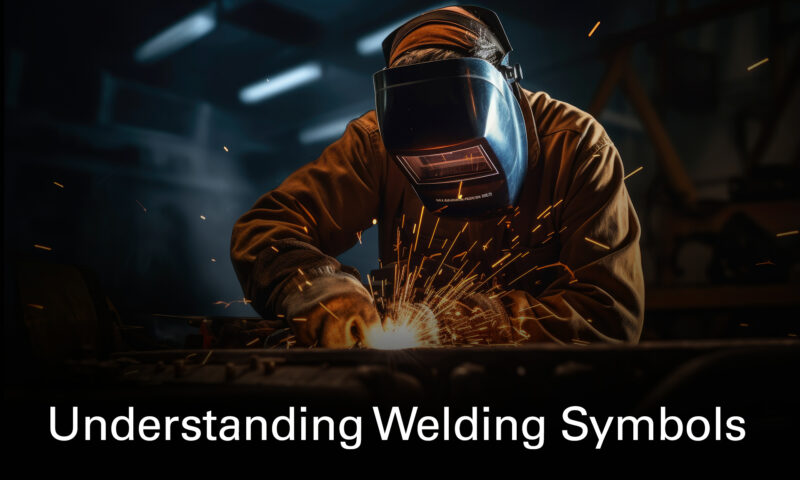To the uninitiated, a welding symbol can look like ancient hieroglyphics. Or some convoluted math problem.
The truth is it’s neither of those. But it’s complex, for sure! A welding symbol on a print is also packed with important information, unlocking the secrets of a weld specification. Within its cryptic marks are all the keys to how and where to perform the weld—if you can decipher it.
That’s what we’re here for. So, without delay, let’s get into our guide to understanding weld symbols.
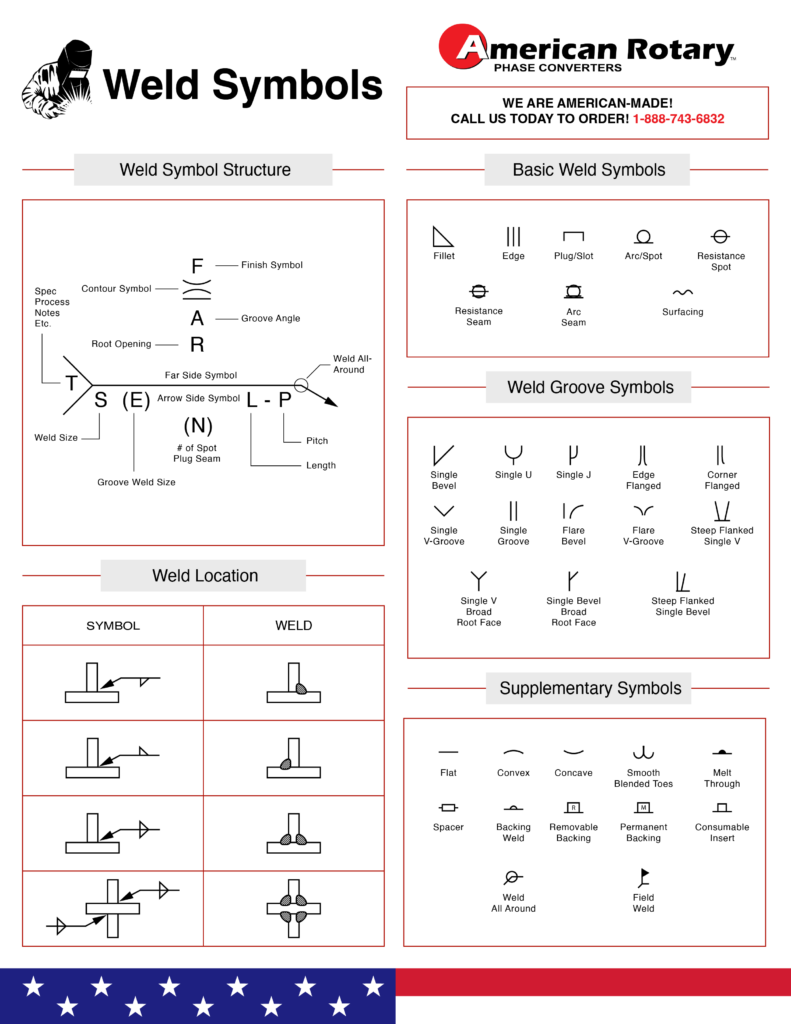
You probably won’t memorize all we’re about to cover. So we made you a handy reference graphic. Download it, print it, and tape it to your toolbox for reference whenever you need.
The Structure Of a Welding Symbol
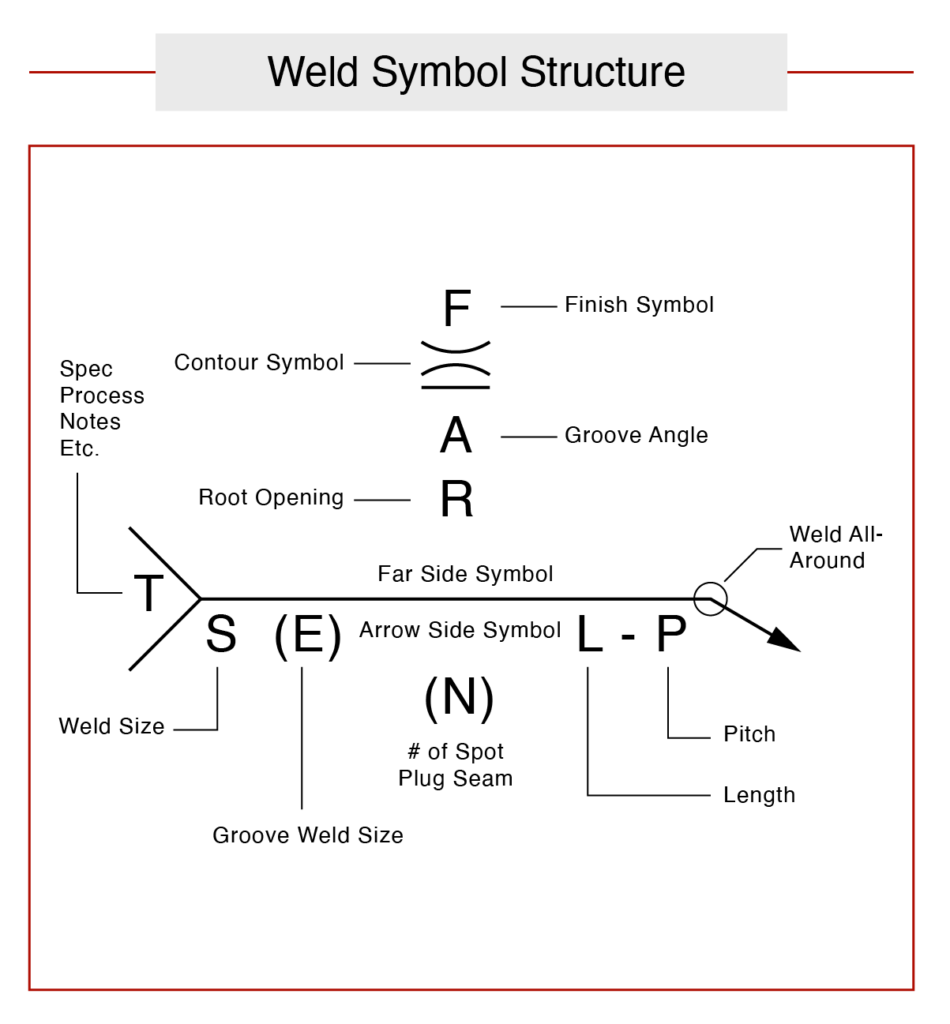
First, a quick note: There are three main systems for welding symbols: AWS (American Welding Society) ASME(American Society of Mechanical Engineers), and ISO (International Standards Organization). They’re pretty similar, with some distinct differences. But for our purposes, we’re using AWS symbols since it is the most common type of welding symbols you’ll see in the United States.
The centerpiece of a basic weld symbol is the horizontal reference line. The arrow at one end of the line points to the location of the weld. The other end is called the tail. It’s used for the specification of the type of welding or additional process notes. The tail might not appear if there’s no additional info needed.
The symbol representing the type of weld goes in the middle of the reference line. All other elements—specs and key dimensions—are posted along the reference line, as well. From top to bottom and left to right, these include:
- Finish symbol – Any required post-weld operations represented by different letters.
- Contour symbol – Showing convex, concave, or flat.
- Groove angle – Angle formed between the prepared edges of the base metals.
- Root opening – Size of the gap between the base metals at the root of the joint.
- Weld size – Width of the weld bead.
- Groove weld size – Depth of penetration of a groove weld.
- Number of spot, plug, or seam welds.
- Length – Length of the weld along the joint.
- Pitch – Spacing between individual welds in a series.
- Process notes – These provide additional information like the type of welding process, the weld materials, or parameters, as well as any type of specific prep or testing that is not included in the rest of the symbol.
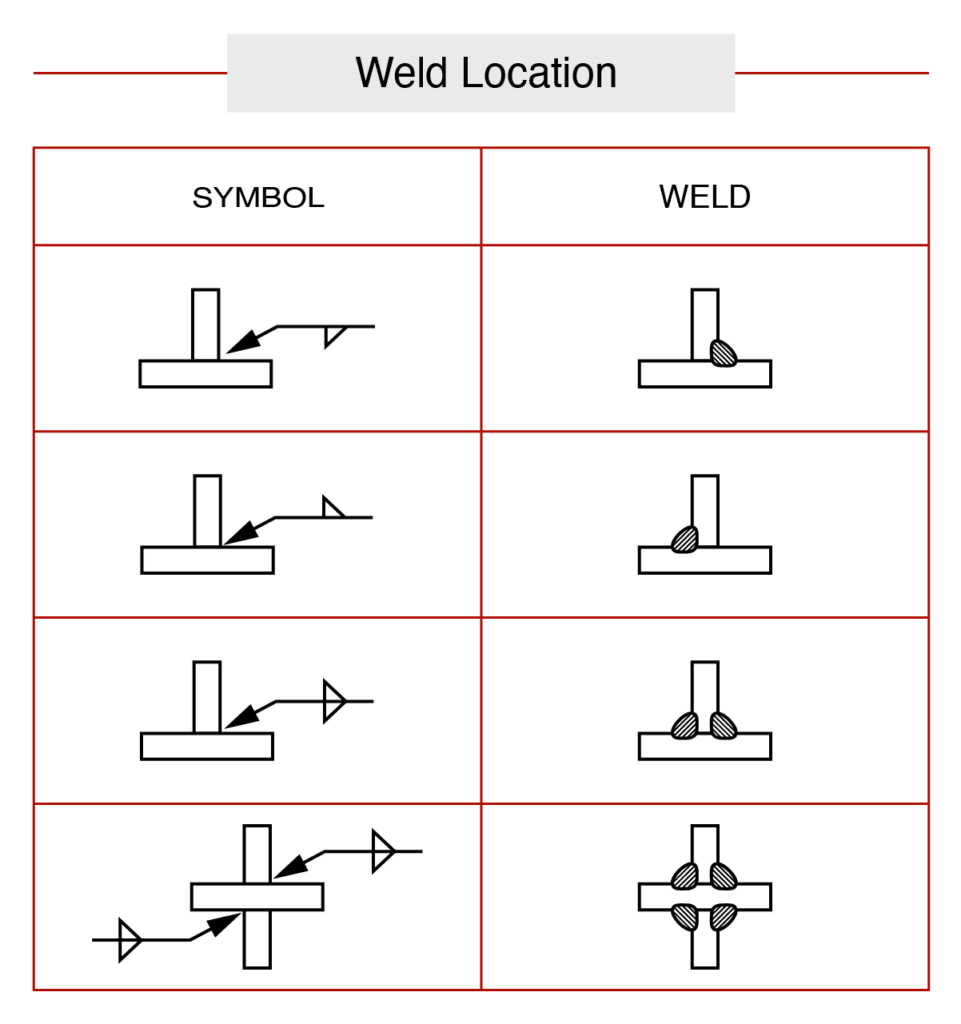
You’ll find weld symbols either above or below the reference line. This tells you which side of a joint the weld should go.
The information below the line means you’re welding on the side of the joint where the arrow is. Above the line is for the other side of the joint. Or you might have info on both sides, meaning you’re welding both sides.
Types of Welding Symbols
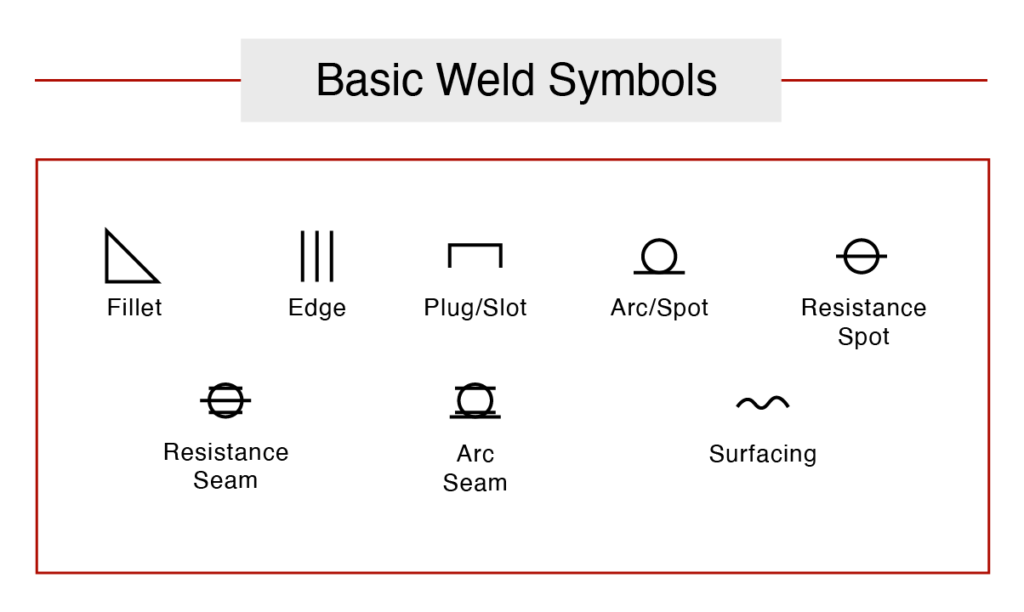
The symbols immediately above or below the reference line tell you what type of weld you’re doing. They’re usually paired with dimensions or other parameters.
Fillet Weld Symbol
The versatile fillet weld joins two pieces at right angles. It’s represented by a triangle above or below the line. Numbers close to the symbol tell you the size of the weld. Two different numbers? One leg should be longer than the other.
Edge Weld Symbol
An edge weld joins two parallel pieces along their edges. It’s common in structural fabrication applications.
The edge weld symbol is three parallel lines.
Plug/Slot Welding Symbols
A plug weld or slot weld provides a smooth surface finish and a strong connection between two overlapping pieces of metal. You fill a hole in one of the pieces with the weld.
The plug/slot symbol is a three-sided figure that looks like a staple.
Arc/Spot Weld Symbols
An arc or spot weld fuses two or more pieces together at specific points using an electric arc.
Its symbol consists of a circle touching the reference line. The number of these circles indicates the number and size of welds required.
Resistance Spot Weld Symbols
A resistance spot weld is like the arc spot weld, but it uses electric resistance heating.
In this symbol, a circle straddles the reference line.
Resistance Seam Weld Symbols
Again, using electric resistance, a resistance seam weld joins two overlapping metal pieces along their length. It’s great for leak-proof joints.
Here, the circle also straddles the reference line, joined by two parallel lines on either side. These represent the seam.
Arc Seam Weld Symbols
As the name implies, this seam weld uses an electric arc.
The circle in its symbol sits along the reference line. It’s joined by two parallel lines representing the seam.
Surfacing Weld symbol
A surfacing weld (aka overlay) goes on the surface of a workpiece. You might use it to restore the dimensions of a worn surface. Or add some corrosion resistance.
The symbol looks like a squiggly line. It always appears below the reference line.
Groove Weld Symbols
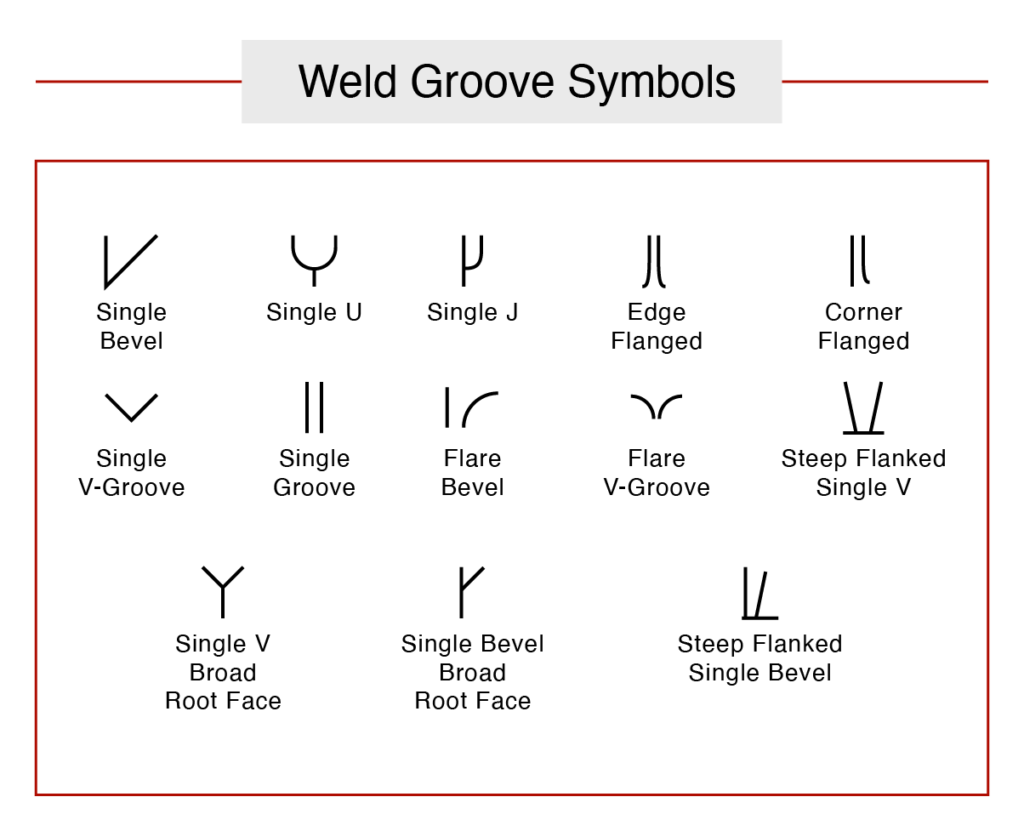
Groove welds join two pieces along a groove between them. This type of weld joint is common with T joints, butt joints, and corner joints.
There’s an array of groove weld symbols. They represent different desired shapes of the groove, including U, V, J, and square shapes, as well as bevels and flanges.
Supplementary Symbols
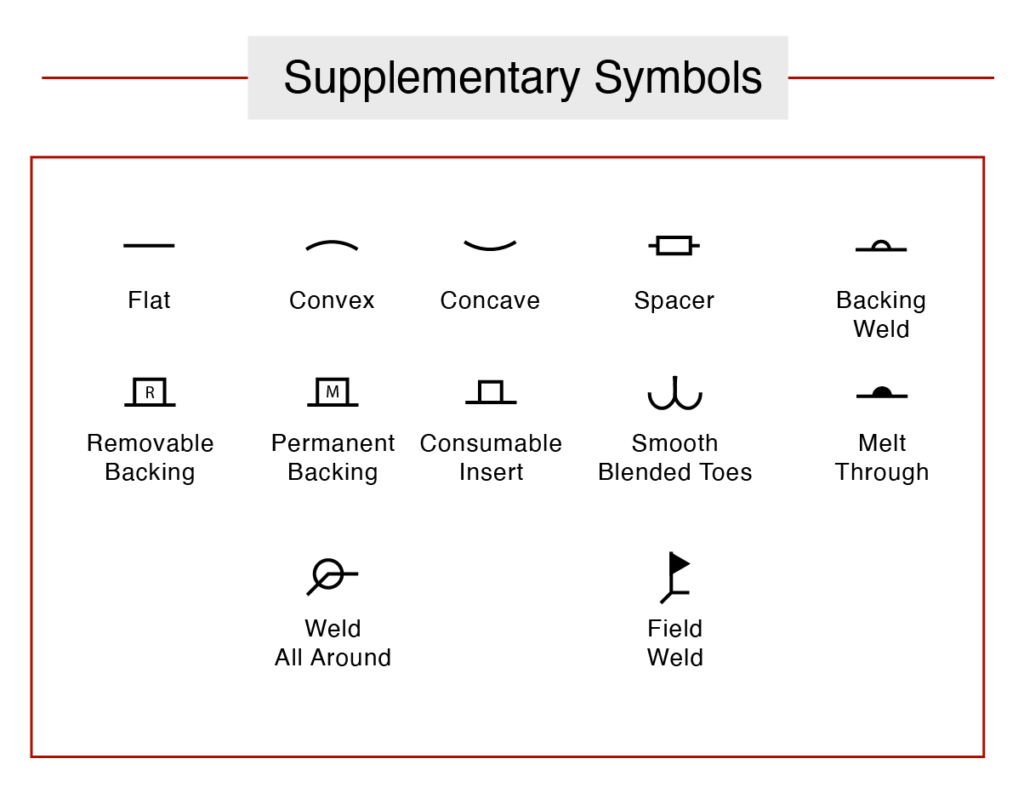
In addition to the fundamental weld types we’ve already discussed, you might find many different supplementary symbols along the reference line. Let’s explore the most important ones.
Contour Weld Symbols
A contour symbol shows up above the weld-type symbol.
It tells you what the final surface of the weld should look like flat, convex or concave.
Smooth Blended Toes Symbols
The toe of a weld is where it intersects with the base metal.
A smooth blended toes symbol tells you that there should be a uniform transition along this intersection. It kind of looks like two fish hooks together.
Melt-thru Weld Symbol
A melt-thru weld is a groove weld that penetrates the entire thickness of the joint—melting through the base metal.
Its symbol shows a shaded hemisphere opposite the groove weld symbol.
Spacer and Backing Weld Symbols
Spacers and backing are different types of weld reinforcements.
Use a spacer to fill a gap between two pieces with additional weld material. The spacer symbol is a rectangle straddling the reference line.
A backing weld symbol is a rectangle above the reference line. It means you need to weld on the opposite side of the joint with backer material for support. The letter R inside tells you to use a removable backing. The letter M denotes a permanent metal backing.
Consumable Insert Weld Symbol
A consumable insert weld involves inserting a metal strip into the joint. This becomes part of the weld and strengthens the joint.
This symbol is like the backing symbol, but it’s a square instead.
Weld All-Around Symbol
If the design calls for welding around the entire circumference of a joint, you’ll see a circle on the reference line where it meets the arrow line.
Field Weld Symbol
See a flag at the intersection of the reference and arrow lines? That means the weld must be performed at a job site vs. in the shop.
Finishing Symbols
At the top of the weld symbol, you might see one of the following letters. Each represents a different finishing process:
- C – Chipping
- M – Machining
- G – Grinding
- H – Hammering
- P – Planishing
- R – Rolling
- U – Unspecified
One Key Thing You Won’t See on a Welding Symbol
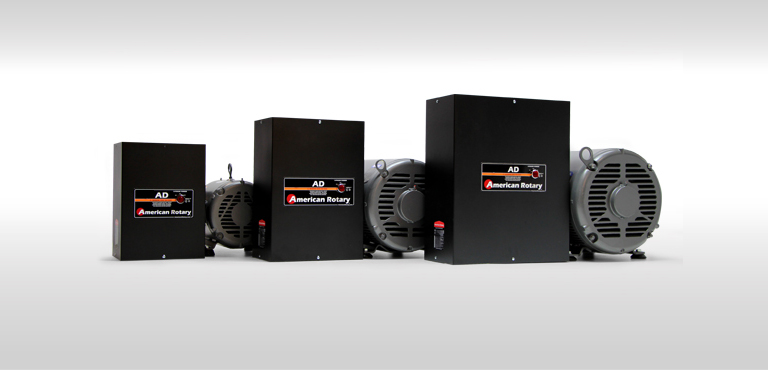
You won’t find anything about power supplies. But that doesn’t mean this issue isn’t important.
Welding equipment needs a lot of electricity. Many machines even require three-phase power (instead of the usual single-phase electric service).
In that case, you can get a rotary phase converter. Properly sized, a rotary phase converter can run any welder—plus all your other metalworking equipment.
A USA-made American Rotary AD Digital Smart Series Rotary Phase Converter, for example, delivers a consistent power supply for smoother operation and cleaner welds. Need help figuring out the right unit for your needs? Check out our guide to 3-phase converters for welders.



